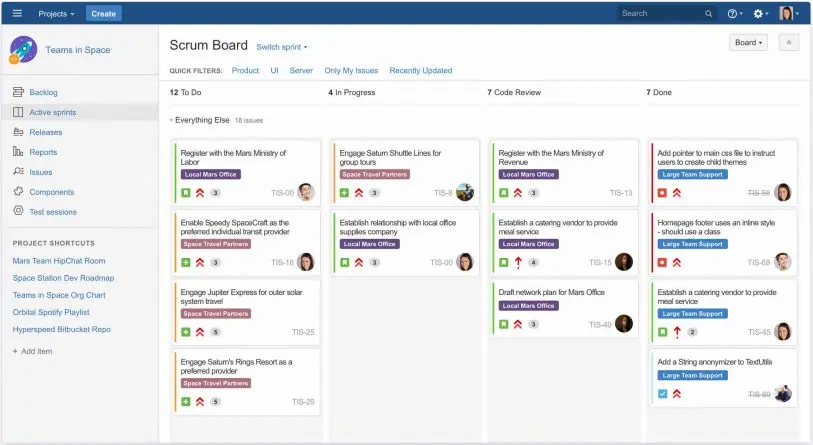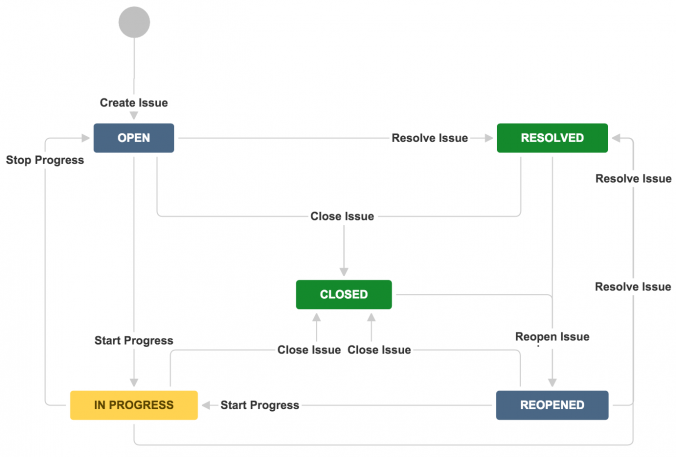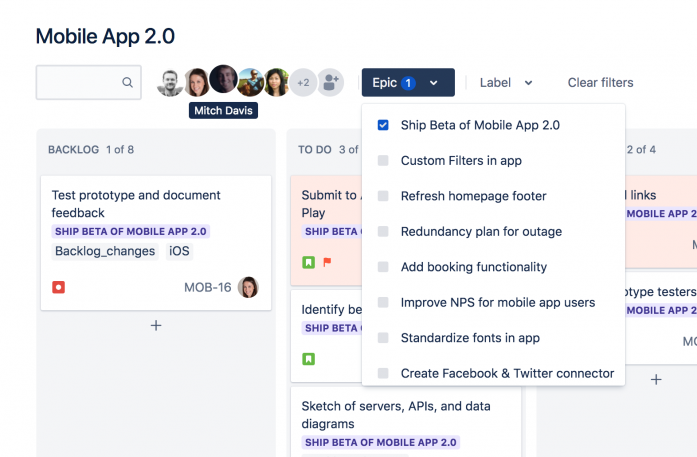If you’ve heard about Australian software giant Atlassian lately–and you’re not a programmer–it may have been over the death of its group messaging app, HipChat. After years of trying to keep up with hot new rival Slack, Atlassian announced in July that it would close down HipChat and Stride, a year-old collaboration app it envisioned as the next step beyond HipChat.
But chat was never the core of Atlassian’s business, and certainly not what’s driven it to a valuation of about $19.5 billion. From its founding in 2002, the company, co-headquartered in Sydney and San Francisco, has focused on project management tools–especially for software developers.
Atlassian’s biggest product line, Jira, dates to the company’s 2002 founding. It’s a de facto standard for coordinating software projects, with anywhere from a handful of coders to hundreds of them assigned to discrete parts. “It’s like writing a book with a different writer on every paragraph,” says Sean Regan, head of growth for software teams at Atlassian, of the challenge that programs like Jira take on.

Others are gentler in their assessment. “Even given that there are pros and cons, I’m yet to see another system . . . that is so flexible,” writes Marat Kiniabulatov, a project manager for warehouse management software developer SkuVault. He was one of over a half dozen people who responded to a request for input that I posted on Twitter. Kiniabulatov may be more patient than others, however. He also leads an Atlassian user group in Russia.
Related: How unsexy collaboration apps made Atlassian a quiet powerhouse
One thing that everyone—including Atlassian’s leadership—agrees on is that Jira needs a refresh. “If you look at the companies that have succeeded over the long-term, they’re the companies that have disrupted themselves,” says cofounder and co-CEO Scott Farquhar.
To stave off disruptive rivals, Atlassian is formally rolling out a suite of changes today to make the interface more flexible and user friendly. (Different pieces of the revamp have been rolling out to groups of users for testing over the past year.)
The updates introduce basic interface features–drop-down menus, checkboxes, drag and drop–that are taken for granted in modern software design. Yet they had been lacking in some key parts of the very planning tool that programmers use to create modern software.
Atlassian is also responding to a fundamental–and not exactly new–change to how software is created, known as agile development. Instead of going heads-down on programming from start to product launch, companies are making steady fixes and improvements. We all experience the phenomenon in the unceasing flow of software update reminders that pervade our lives.
The drag-and-drop method of arranging boards resembles Trello. [Animation: courtesy of Atlassian]Jira was built at the turn of the century in an era of big, tightly controlled projects, running on servers inside a company. “When I wrote version one of Jira . . . back then there was a software team,” says Farquhar. “Then they shipped some code . . . then it got pressed on a CD.” On and on he goes, describing distinct, barely coordinated phases and teams. “It would be a year before any bug fixes came out,” he adds. Now all those phases of writing, servicing, and updating software are happening simultaneously and deployed via the cloud.
While Jira has had many big upgrades over the years, it also faces a mind-numbing roster of project- and task-management competitors, such as Asana, GitLab, Microsoft Azure DevOps, Pivotal Tracker, and Rally. Many rivals are newer, built with agile development in mind, and designed to run as subscription-based cloud services rather than on-premises software.
Atlassian launched its first cloud-based version of Jira in 2007, but the current version dates to 2016. That’s when Atlassian decided to fork its code base, resulting in independent, ultimately incompatible versions of Jira–one for in-house servers and one as a cloud offering. Today’s upgrades apply only to the cloud-based version.
The Trello lesson
In 2017, Atlassian bought one popular Jira alternative, Trello, for $425 million. Jira’s new upgrade shows the influence of the acquired service, which lives on under Atlassian ownership.
“Trello has been very instructive for us,” says Farquhar. “It starts with very little structure and control, and you build up and add those things.” Jira has been the opposite, rigidly controlled by an administrator with special access rights to make updates and customizations.
In Jira in its classic form, “as an administrator, some things are easy and other things are unnecessarily complicated,” says Victoria Guido, an engineer at consulting company Blackstone Federal who replied to me on Twitter. “It’s easy to see how people can quickly make it into something ugly and cumbersome.” Guido leads an Atlassian user group in Washington, D.C.

It’s the kind of drag-and-drop flexibility you’d expect in software today, but a big upgrade for Jira. Until now, changes to the board required going into a separate interface, called the workflow editor—a flowchart rat’s nest of rectangles and arrows defining the order for every step in a process.

Unlike Trello, which starts from a blank slate, Jira lays out basic board templates for different project styles. In the past, users would have to commit to a style at the beginning, such as the popular scrum or kanban organizational methods. Now Jira allows users to turn different elements on or off rather than being locked into one method.
Scrum, for instance, is based on a time-defined unit of work called a sprint, typically running for two weeks. With the new upgrades, even teams that didn’t start with a scrum system can activate sprint scheduling at any time if they want to change their workflow.
Atlassian also made it radically easier to filter views of the boards–for example, to see just the issues that a particular developer had worked on in the past week. Previously, users had to code a custom query in JQL (Jira Query Language) even to get basic information, such as viewing all the projects they were working on. Now they just click an icon with their photo. (Writing custom queries is still available for more complex searches, though.)
Mike Solomon, VP of people operations at Group Nine Media, the publisher of sites such as Thrillist, is a Jira user. After chatting with him on Twitter, I asked Atlassian to give him access to the new features. “This is a huge improvement for the look and feel of Jira,” says Solomon, who works with nontechnical teams and found the new design much friendlier.

Twine is currently split between Jira for its technical teams and Trello for the others, but now it might be easier for everyone to use Jira. That’s a key part of Atlassian’s plans for expansion. “Software is the center of work for most companies these days,” says Farquhar, making the case for integrating all company planning into Jira.

Related: How GitHub employees use GitHub for projects beyond coding
But Atlassian may have a lot of convincing to do–especially as it competes with rivals designed with more mainstream use in mind. “It’s a difficult task manager for non-engineers to follow,” says Ryan Bednar, an engineer and CEO of search engine optimizing service RankScience. “We switched from Jira to Asana and experienced a major productivity boost.”
And all the new interface upgrades are currently only in the version of Jira for developers, called “Jira Software.” The company hasn’t confirmed if the upgrades will come to Jira Core and other specialized versions of the service.
Playing nicer with others
Along with the big changes to Jira’s design is the ongoing process of improving integration with many other pieces of software. It has to work closely with outside code repositories like GitHub, for example, as well as other Atlassian products like Confluence–a kind of wiki for developers to keep notes on their work. (Jira and Confluence account for more than two-thirds of the company’s revenue, which was $874 million for the fiscal year ending in June.) Atlassian also runs a marketplace with about 3,000 third-party apps that plug into its products.
Jira has long had some integration with Slack, as well. The companies may have been rivals in the group-messaging market, but they also had to work together for the many users they had in common. Jira can currently post updates on projects to Slack channels, for instance. Regan says to expect tighter integration in the near future, though he doesn’t provide details.
Slack actually purchased the intellectual property for HipChat and Stride, to aid migration of users to Slack after the Atlassian services shut down in February 2019. And Atlassian made what Slack CEO Stewart Butterfield called a “small but symbolically important investment” in his company in a series of tweets in July. The former rivals now talk about a partnership.
I press Farquhar on any takeaways from the HipChat experience but don’t get an indication it will change much. HipChat was just one of about two dozen acquisitions that Atlassian has made over years, he says, most of them successful. The company will make more acquisitions when it makes sense, he says. It will build new products, and it will do partnerships.
“We pride ourselves as a company on making the tough, right decisions,” says Farquhar. “We want to be around here in 50 years’ time.”
Recognize your brand’s excellence by applying to this year’s Brands That Matter Awards before the early-rate deadline, May 3.